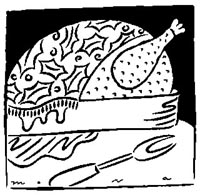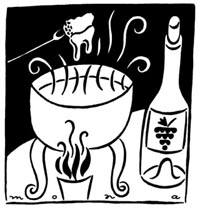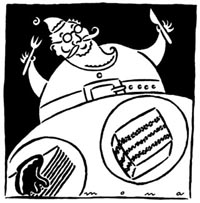Season's Grazings
Fri., Dec. 18, 1998
Virginia's Famous Dishrag Turkey
|
|
My father passed away during the Christmas of 1976, and the next year my younger sister and I joined Mother for a brave and lonely holiday meal in Midland. I had begun cooking and catering professionally by that time, and Mother and I got up early to get the bird in the oven, start the stock for gravy, and make some rolls. As the morning progressed, we wondered aloud just when Suzy might join us, but it was nearly 11am before she strolled into the kitchen in search of her first cup of coffee. "You'd better get in here and pay attention," Mother told her. "One of these days, I'm going to pass and Virginia won't be around and you'll be sorry you never learned how to do all this." Seemingly unconcerned, Suzy poured her coffee and turned to go. As she left the kitchen, she looked at me and said, "Where'll you be?" never breaking stride.
I spent the next several years perfecting my own holiday meal presentation and eventually I learned what for me was a foolproof technique for a delectably moist turkey with a crisp, golden skin. My method was horrifying to Mother but unquestionably delivered a delicious turkey of which everyone approved. The basting method sometimes set off the smoke alarm, but that didn't bother me nearly as much as it did everyone else. I wanted the perfect turkey. I was never more satisfied in this life than when I received the Christmas Eve phone call from Suzy at Mother's house. She said, "Explain to me again about the dishrag."-- V.W.
RECIPE
Festive Fondue
|
|
My dad is, as the saying goes, a "man of the cloth," which means that the holiday season -- Christmas Eve, in particular -- never fails to be a hectic time. Although we're a family of confirmed foodies who at other times of the year find certain sanctuary behind the stove, Christmas finds us spending more time at the church than in the kitchen. Ecclesiastical obligations turn holiday meals into eclectic affairs, but no matter what's on the menu, our traditional cheese fondue always finds its way to the table.
According to Mom, we started having fondue because it could be put together ahead of time and it "had a festive air about it." The recipe we use originated in the kitchen of American cooking maven Helen Corbitt, but we've added to it over the years, jazzing it up ever so slightly. As a kid, I couldn't wait to dunk crusty bread into the blend before Mom poured in the kirsch. After the unfailing reprimand for eating out of the pan, I would be told that I'd appreciate the alcohol addition when I grew up. Mom knows best. Without the contribution of something alcoholic, the recipe falls flat, so I add kirsch (in a smaller dose than Mom does) or pour in a splash of white wine. It isn't really Oklahoman, but cheese fondue starred on our holiday table every Christmas I spent on the plains. -- Rebecca Chastenet de Géry
Sedimentary Cheese
|
|
The first was a remarkable Roast Duck with Bigarade Sauce: puffy, crisp skin and tender, grease-free meat (Raymie is the world's master at extracting every molecule of fat from a duck carcass while roasting it to a golden brown), with a rich, sweet but tangy, carmelized l'orange sauce with demi-glace. The second was a new one for both of us: a Thirty-Layer German Baumtorte. The concept was simple when examined rationally: basically very thin layers of crêpe batter browned quickly under a broiler, then topped with an apricot glaze with Gran Marnier and chopped hazelnuts; repeat 30 times in a springform pan; when the pan is full, let cool, trim, and cloak with a dense orange-chocolate glaze and more filberts. A slice of this stuff is absolute heaven -- 30 thin layers of dense lightness, setting off a taste bud battle of chocolate, hazelnuts, and orange-apricotosity. It has to be the most addictive substance known to mankind -- forget bingo, cocaine, latte, nicotine, the unfailing love of a Labrador puppy, or anything else a junkie holds holy. I had it for breakfast, lunch, and dinner until every last crumb had been inhaled. I jones for a slice still today.
But the real historical standout of the feast was my very first Layered Italian Cheese Terrine. Over the subsequent years I've sold thousands of slices of this sedimentary cheese treat. The exploded view features layers of cream and Italian cheeses with garlic and herbs, enclosing layers of roasted red bell pepper, pesto, and chopped black olives. Although the first one had layers of pine nuts, prosciutto, and pesto, you can make the filling layers of whatever you like. Once I streamlined the production for the masses, it became very fast and simple to make, an Italian cheese feast for the mouth. It makes a great dish for parties and potlucks, and it can be frozen for later use. -- Mick Vann
Returning Home
|
|
But there was an underlying cause for my holiday disenchantment that I always felt too guilty to admit. Although I've known my family as the kindest and most generous, we are also top contenders for Woody Allen's worst nightmare. Our dysfunctions aren't necessarily worse than other families, just more obvious, louder. Our default volume is "scream" and our conversational mode is to interrupt. Rather than join in, I grew up shy and reclusive amidst all this. Even until recently, the family hoo-ha would continue to intimidate and disenchant me, especially at holiday meals.
Other families don't begin dinner before sundown just to shove the kids off to bed. They might chat a bit before eating, rather than talk through full mouths as they go. They might indulge at cooking, rather than opt for the thoughtless convenience of deli trays. They might chew with just one mouthful of food or grab for seconds only after each person has been served first. But in my family, mealtime is much like a circus, a survivalist's game. We eat like whales before a massive migration, with as much couth as orangutans.
After I became a professional cook, I grew disgusted by this gluttonous display and lamented the gracious meal gone bad. On each less frequent trip home, I'd plead the case of genteel etiquette to my sympathetic but pessimistic mom. My "platform of refinement" amused her; she knew that little about our family habits could ever evolve -- that, in fact, our family's growing dispassion with tradition and our suffocating general wackiness was an expression of utmost comfort and love. Sobriety, she'd tell me, just isn't our way.
I never understood her point until I was home for the holidays this year. My granny, whose condition had been quickly deteriorating, died just before Chanukah. With Granny gone, I thought that holiday meals wouldn't be the same, that old Jewish jokes wouldn't generate the same guffaws, and that people would talk congenially to each other instead of shouting every which way. It would be the kind of meal I once petitioned for -- civil, refined -- but, I now know, not fitting with my family's need for bawdy, manic love. For even in the midst of tragedy, my family manages to shun propriety. While sitting Shiva, a Jewish tradition of community mourning, we laugh at excessive toasts with champagne and rude jokes. With visitors, we gather to eat, drink, and exchange emotions. Rather than mourn solemnly, we relive colorful moments of the most magnificent woman we all ever knew, and with utmost adoration. We eat with a conviction born from catharsis and re-enact unconsciously memorized family scenes. Our sadness leaks out in laughter as in tears.
Our table manners will no doubt remain unchanged, for what I now realize is that my family's interminable zaniness is never a distraction from the real occasion; it is itself the cause to commemorate. My family's character is the thing to pay tribute to, what is truly most sacred. Even if our reasons for coming together are tragic, the gathering itself is the important thing.
Yes, this is the time of year that food essayists wax sentimental about classic foods or prized family recipes. They trumpet principles of culinary preservation and home cooking, as I've done for years. I do think that food gives us guidance. We don't, for instance, always remember how to commemorate a holiday, other than knowing what to eat. But this year, I feel dispassionate about such ideas. It is laughter and love, not the perfect brisket or ham, that sustains a family each season. I do have my stock of traditional recipes -- we all do. I'll always serve my granny's potato latkes. But now I know that what I eat is less important than who I eat it with. The simple act of putting on a meal will keep Granny's legacy alive and have me, at all costs, returning home.
-- Ronna N. Welsh
Creatures of Habit
|
|
This is the week out of the year that I've planned to gaze at the dark sky as snowflakes cascade in front of twinkling streetlights and white lights strung through the trees, my moist breath making a wooly muffler itch my mouth. Suffice it to say that I get ornery if it's balmy outside. I want my same stocking every year, I want my 32-year-old sister to sleep in her childhood bedroom on Christmas Eve, I even want to shovel and come inside to eggnog with ein Schlag -- one slug (or more) of whiskey, as my German brother-in-law likes to say, or cocoa, with cookies.
This year, I already know that something's going to be different. For each of my 27 years, the lady next door has prepared a box of Christmas cookies for the Phillips family. These are not typical cookies -- so far as our tribe has determined (and we are determined, when it comes to food research), no other cookies like this exist on earth. This is not to say that the special Mabel Ash Christmas assortment comprises the best, but rather the most outlandish kinds of cookie that exist.
In the box, there are 10 kinds of cookie, each kind relegated to its own old-style baggie with a fold-down top. Because there are four of us, there are always four of each kind of cookie, and the smartest person is the person who gets to the box first. He or she can lay claim to all of the lemon squares, or all of the crisp, lacy cookies whose main ingredient seems to be molasses, or the shortbread cookies that bespeak her Scottish heritage. These were the highly desirable cookies of the bunch.
Whoever got to the box next might find themselves snacking on meringue bombs with a strange secret ingredient, or macaroons with a slice of glacéed cherry stuck in the top.
Then come the bar cookies. Cookies that by rights should be chocolate-chip cookies made in a pan. Instead, these cookies are brimming with things like raisins and what may even be carob. Even these get eaten before the spice-laden fruitcake bar cookies, the only other venue for cherries died bright green. Last, and least, are the date swirls.
Last year at Christmas, Mrs. Ash, who is pushing 90, explained that because of failing health, she hadn't really been able to refer to the recipes. But she made her cookies anyway, and they all turned out exactly the same.
This September, Mrs. Ash finally sold the house she'd lived in for 35 years and moved to a place where she'll have oxygen at her disposal and all of the medical care that she needs. It's finally safe to assume that since she gets her meals cooked for her, no cookies will be forthcoming this year. We didn't even really like the cookies, but we are creatures of habit, and we are certain to miss them.
So this year, to keep the collective mood intact, it will be extra-important to accomplish our own cookie-making tradition -- making a very few batches of easy-to-make, easy-to-eat thumbprint cookies. We only make them for the family, and they only usually happen in a moment of stress at 1am on Christmas Eve. It generally turns out that they all get eaten straight out of the oven, but that's the way we like it. It's tradition. -- Meredith Phillips
Visions of Sugar(plums)
|
|
But thanks to the magic of my aunt Noel's Instamatic, I can reconstruct a few key facts. I know that we packed my grandparents' house with kids. I know that we all wore footie pajamas. And most importantly, I know that we ate our collective weight in Christmas cookies.
If you scan our family photo albums, every kid in a Christmas picture seems to be holding a half-eaten oatmeal cookie. Five-year-old cousins trim the Christmas tree gripping handfuls of pecan shortbread. Tiny smiles are dusted with a perpetual layer of powdered sugar.
Cookies and assorted homemade candies appear in every other picture because they provided the fuel for our biggest family gathering. For the kids, the constant flow of sweet treats propelled us through the annual reunion and kept our collective blood sugar level in the stratosphere.
Christmas around the Hebert house was a mob scene of a celebration. In the early years, my mom and her seven siblings gathered in Baton Rouge for a week of Yuletide visits and frenetic holiday chaos. About a week before Christmas, my mother's brothers would come in from northern exile, adding countless carloads of cousins to the swelling ranks of local grandkids. The four Hebert boys (Lee, John, Bart, and Charlie) would come down from Chicago. Barbara and her kids flew in from Colorado. Sometime around the 20th, the extended family achieved critical mass, triggering a long run of high-sugar fun.
Our grandmother would pack the smiling pig-shaped jar with her famous oatmeal cookies and bake countless batches of whisper-thin teacakes. Fruitcake tins from Corsicana -- blissfully relieved of their weighty cargo -- would be repacked with rich slabs of fudge and sour/sweet lemon squares.
"The girls" -- my mother and her sisters -- each provided their own special treats. My godmother Lula (third child, second girl) always brought elaborately iced sugar cookies in various Christmas shapes (fat Santas, pointy Christmas trees, lumpy camels) in foil-lined boxes. My mother whipped up her creamy pralines using fat local pecans and dark cane syrup. The birthday girl and youngest child Noel made just about everything else, from bite-sized pecan pies to butter-heavy shortbread "cocoons" that literally melted in your mouth.
Then there were the edible gifts given by family friends, offerings that became as much a part of our Christmas tradition as the blinking tree. Decorative containers filled with Missy McDermib's "top secret" orange muffins sat beside the salty cheese straws from Anne Jane's kitchen. Nuns from a local convent always gave my grandfather a few tins of velvety divinity fudge -- beautiful blobs of rich albino sweetness, each topped with a perfect pecan half.
Over the course of Christmas week, adults and children alike managed to work their way through the ton of accumulated sweet stuff, all the while smiling for impromptu portraits in front of exploding flashbulbs. There were a few token "real meals" thrown in for good measure, but the magic sweets always sustained us nicely for our weeklong reunion. Any unlikely leftovers would be split into empty tins and dispatched with departing families for the long ride home.
Months later -- just as everyone's blood sugar had returned to normal -- the Christmas pictures would circulate from sister to sister to sister-in-law and back again.
And for those of us who can't remember anything past the cookie-fueled blur, we're grateful for this photographic record. Luckily, when memory fails, we can still check the family albums and remember the times when we were all still wide-eyed and very, very sweet.
-- Pableaux Johnson
Virginia's Famous Dishrag Turkey
1 thin, white, all-cotton washcloth, dishrag, or grill towel (cheesecloth will do)
1 lb butter, melted
Tony Chachere's Creole Seasoning
1 fresh, all-natural turkey (I always order the Jennie-O Brand at Fresh Plus)
large roasting pan
tongs
Remove turkey from the fridge about one hour before baking time. Remove giblets and neck from body cavities and reserve for gravy stock. Rinse thoroughly in a very clean sink and drain. Rub all over, inside and out, with some melted butter and season liberally with Tony's. Check the weight of the bird and consult the package for the necessary cooking time for that weight. Preheat oven to 425 degrees. Place turkey in roasting pan. Soak dishrag in melted butter and place on the turkey, covering the breast and the tops of the legs. Put turkey in hot oven and immediately reduce temperature to 325-350 degrees. Set timer for 30 minutes. When timer goes off, remove rag carefully with tongs, soak in butter again, and replace on bird. (If you drip fat on the oven door, this will eventually smoke and may set off smoke alarm. Designate someone else to disable the smoke alarm, so you won't break your neck before the turkey's done). Reset the timer for 30 minutes and baste again. After the third basting, there should be enough fat in the bottom of the roasting pan so you can dip the rag in that fat or use a turkey baster to suck it up and pour it over the rag. Continue basting every 30 minutes until the last 30 minutes of the suggested cooking time. At that point, use tongs to remove dishrag and discard it. Allow the turkey breast to brown, then check for doneness with a meat thermometer. Remove bird from the oven, allow 20-30 minutes before carving. Accept accolades graciously. Have someone reset the smoke alarm after dinner.
Holiday Cheese Fondue
2 Tbs butter
2 Tbs flour
1 cup milk
2 heaping cups grated gruyere cheese
white pepper
garlic powder
Worcestershire sauce
Tabasco
kirsch (cherry liqueur) or dry white wine
one crusty baguette, cubed
In a heavy-bottomed sauce pan, melt butter and make a basic white sauce, adding flour and whisking constantly until thick. Gradually add milk, stirring continually. Once sauce has thickened, gradually stir in cheese. Season to taste with white pepper, garlic powder, Worcestershire sauce (go easy here, or you will discolor your fondue), and Tabasco. Prior to serving, add a generous splash of kirsch or white wine. Taste for seasonings and serve with chunks of crusty bread. Note: When serving, avoid using a sterno to keep fondue warm, as the mixture tends to burn. Use a fondue pot or saltron pad instead.
Layered Italian Cheese Terrine
(Yield, approximately 12-14 slices)
a metal loaf pan, 4" x 8" or 5" x 9"
16oz cream cheese, softened
2 cups grated cheese mix (any combo of asiago, mozzarella, provolone, parmesan, fontina, romano)
2 Tbs garlic, minced
1 Tbs each: fresh parsley, basil, oregano,
all minced (or 1/2 the amounts dried)
1/2 tsp each, salt and white pepper
3/4 cups pesto
3/4 cups roasted, peeled red bell peppers,
chopped (or pimento)
3/4 cups pitted black olives, chopped
2-3 slices mozzarella, 1/2" thick
2-3 slices provolone, 1/2" thick
Combine cream and Italian cheeses, garlic, herbs, salt, and pepper in a bowl and mix very well. Press mixture onto a cookie sheet lined with plastic wrap in a layer about 1/2" thick. Chill about one hour or until very cold. Lightly oil the loaf pan and line with plastic wrap. Piece together a seamless layer of the mozzarella slices in the bottom of the pan. Cut a section of the filling to fit over the mozzarella. Drop the pan from a low altitude to compress the layers. Add the pesto on top of the cheese mix and smooth out with a spatula. Repeat the procedure with mix, then red bell peppers, then mix, then the olives. Add the last piece of cheese mix, and top with a seamless layer of provolone. Cover well with plastic wrap. Chill or freeze for later consumption. To serve, cut with a warm, non-serrated knife into vertical slices, so that all the layers show. Serve with baguettes, bagel crisps, or crackers. Eat any leftover cheese mix twixt bread for a grilled cheese.
Granny's Potato Latkes
2 russet potatoes, peeled and coarsely grated
1/4 large yellow onion, or to taste, grated
pinch or two of flour
salt and pepper
vegetable oil for frying
Heat oil until a piece of potato sizzles when dropped into skillet. Form latke patties -- we like them thin and small -- about two inches in diameter and about a quarter-inch thick. Fry on both sides until golden brown. Drain on paper towels. Serve hot with applesauce and sour cream.
Thumbprint Cookies
1/2 cup shortening, some or all of which is
butter
1/4 cup packed brown sugar
1 egg separated
1/2 tsp vanilla
1 cup flour
1/4 tsp salt
3/4 cup pecans chopped fine
fruit preserves (apricot, cherry, raspberry
are nice)
Mix shortening, sugar, egg yolk, and vanilla. Blend flour and salt, stir in. Roll in one teaspoon balls. Make them very tiny! Beat egg white slightly with fork. Dip balls in egg white and roll in nuts. Place about one inch apart on baking sheet. Press thumb gently in center of each. Bake in oven at 350 degrees 10 minutes or until set. Cool. Fill with preserves. Makes three dozen (if tiny).
Juanita's Lemon Squares
Crust:
2 cups flour
1 1/2 sticks oleo
1/2 cup powdered sugar
Cut oleo into flour and sugar with pastry blender. Pack in a greased and floured 9" x 12" cake pan (or spray with Pam). Bake in oven at 350 degrees for 15 minutes.
Filling:
4 well- beaten eggs
2 cups sugar
4 tsp flour
1/2 tsp baking powder
6 Tbs lemon juice
Grated rind of one lemon
Mix all ingredients together. Pour over the baked crust and bake at 325 degrees for 25 minutes or until lightly browned and set. Cut into squares while warm. Dust with powdered sugar.












